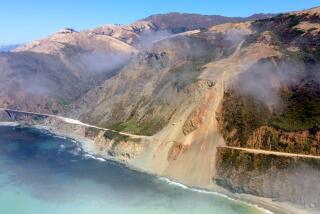Divided road
It’s a big dispute for such a small road.
An obscure 8 1/2 -mile jeep track in the White Mountains northeast of Bishop has escalated into the latest battleground between groups seeking vehicle access to public lands and environmentalists who seek to preserve sensitive areas.
Furnace Creek Road, off Highway 264 near the California-Nevada border, in part traverses a desert wetland fed by runoff from the arid eastern slopes of the White Mountains. It winds through cottonwoods, birch trees and cattails that rise along a slow-moving stream.
“It’s not really about the road,” says Richard Hatfield, project manager for the U.S. Forest Service. “It’s about two groups that have very different ideas on public lands management, and this is the place that they’ve both drawn lines in the sand.”
Two years ago, the Bureau of Land Management and the U.S. Forest Service -- which each have jurisdiction over sections of the road -- closed the route because of pressure from the Center for Biological Diversity, the Sierra Club and Public Employees for Environmental Responsibility. Since then, four-wheel-drive enthusiasts led by the High Desert Multiple Use Coalition have fought to reopen the seldom-used road.
With an environmental assessment of the road nearly finished, the agencies plan to announce a decision in mid-June whether to reopen the road. During the public comment period, more than 3,000 people responded.
Hatfield says the agencies are leaning toward reopening the road to small motor vehicles such as ATVs and motorcycles but keeping it off-limits to larger vehicles.
“To me, it’s not all or nothing,” he says. “The entire ecosystem is not going to collapse with the limited use that we’re looking at out there.”
The proposal, offered as a compromise, has angered many of the players.
The environmental groups want the road to remain closed to all motor vehicles, saying drivers carve up the wetland that’s home to yellow warblers, sage grouse and other animals.
The four-wheelers downplay the ecological importance of Furnace Creek, saying it’s nothing more than a wash that’s bone-dry most of the year. They also dispute the Forest Service position that the wetland serves as an important migration stop and spring nesting spot for many birds.
The dirt road was cut more than a century ago to access gold mines. During the 1980s and ‘90s, ranchers used it to transport stock to grazing land. Occasionally, hikers, motorcyclists, ATV and jeep riders turned off the highway and onto the minimally maintained road.
In January 2001, environmental groups filed a lawsuit to force the federal government to close the road, claiming that motor vehicles damaged the riparian habitat. After monitoring its use for two years, authorities installed a gate, prohibiting motor vehicle use pending an environmental study.
Since the closure, recovery within the wetland “is quite evident,” the Forest Service reports, “with robust populations of carex, willow and water birch covering the ruts that traversed through the riparian areas.”
Paul McFarland of Friends of the Inyo, an advocacy group that favors keeping the road closed, hopes the recovery continues. He describes the riparian area as “the threads of life that hold the web of desert life together.”
Daniel Patterson, an ecologist for the Center for Biological Diversity, says it’s inappropriate to run a road through a wetland. The debate over Furnace Creek Road, he says, has become “a line in the sand because the White Mountains are a spectacular place, one of the wildest places left in California. It’s an outstanding place and people who live in Inyo and Mono counties know this.”
Ron Schiller, who lives in nearby Ridgecrest and is chairman of the High Desert Multiple Use Coalition, has led the charge to open the road to four-wheelers.
He too cherishes the area for its wild nature but wants to be able to use the road to access one of his favorite deer hunting spots.
“Everything else is so commercialized and hacked up,” he says. “The only place that I have left that allows any kind of freedom is the White Mountains.”
More to Read
Sign up for Essential California
The most important California stories and recommendations in your inbox every morning.
You may occasionally receive promotional content from the Los Angeles Times.










